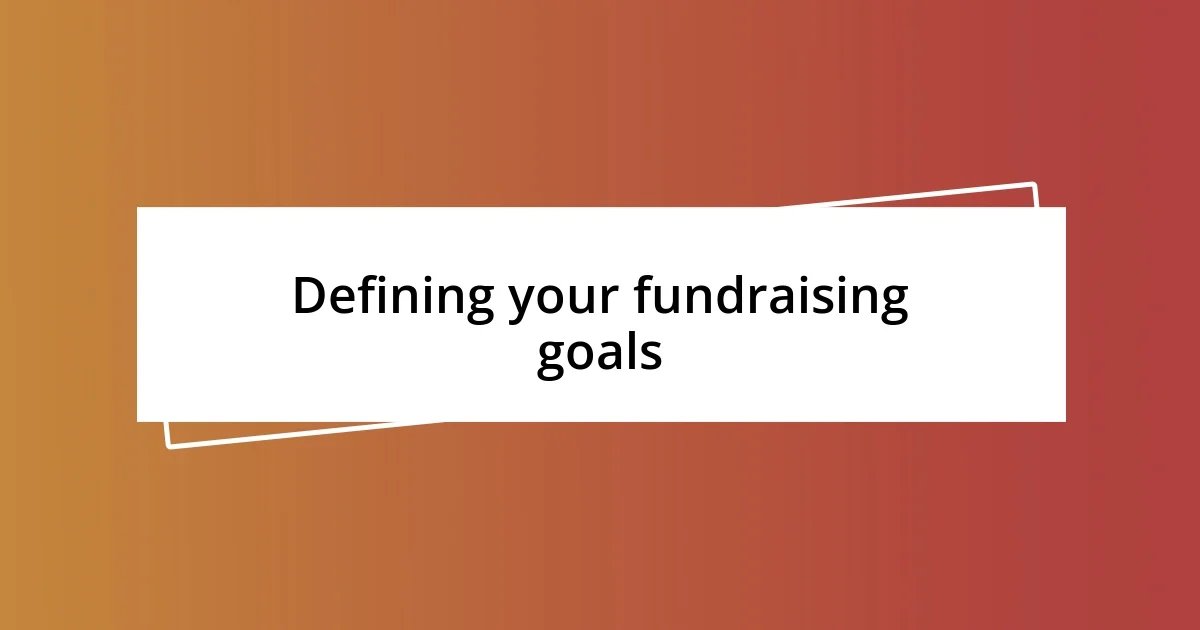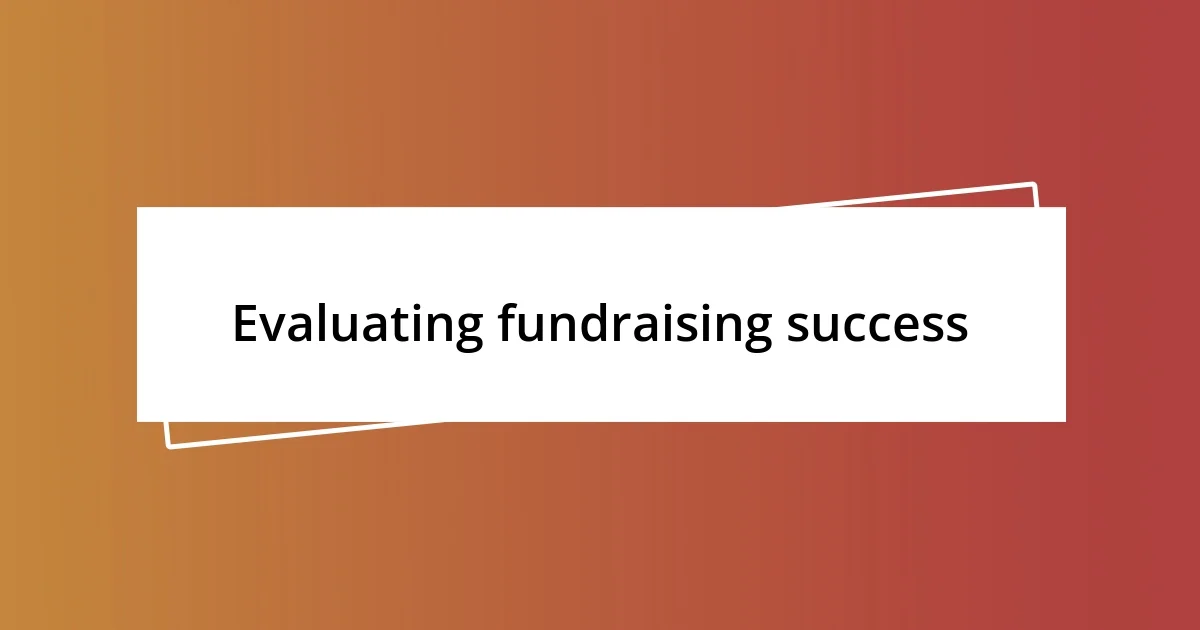Key takeaways:
- Successful fundraising begins with a clear mission, emotional storytelling, and building genuine relationships with potential donors.
- Define specific, measurable, and flexible fundraising goals that align with your organization’s mission to maintain focus and motivate your team.
- Engage donors through personalized communication, involve them in decision-making, and evaluate success by analyzing both financial results and donor relationships.

Understanding fundraising basics
Fundraising begins with a clear understanding of your mission and objectives. When I first dived into fundraising for my favorite charity, I realized that being passionate about the cause was just the starting point. What really made a difference was articulating our vision in a way that resonated with potential donors. Have you ever felt that thrill when someone connects with your passion? It’s incredibly powerful.
At its core, successful fundraising involves building relationships. I remember a time when I personally reached out to local businesses for support, and instead of just asking for donations, I took the time to share our story and the impact their contributions would have. The conversations became more about collaboration than just transactions. Isn’t it incredible how a little personal touch can transform a simple ask into a meaningful partnership?
Additionally, understanding your audience is crucial. Think about who you are trying to reach and what motivates them. For instance, when I tailored our messaging to highlight community impact and personal stories, I saw an increase in engagement. It struck me how emotional connections could inspire giving. Have you thought about what stories you could share that might resonate with your audience? Those heartfelt narratives are often what inspire people to lend their support.

Defining your fundraising goals
Defining your fundraising goals is like drawing a roadmap for your journey. I remember setting a specific financial target for a small community project – it was daunting at first, but breaking it down helped me see it as achievable milestones. When I realized every little goal could lead to greater impact, I felt a surge of motivation. It became more than just numbers; it was about real change in people’s lives.
To effectively define your fundraising goals, consider these key points:
- Clarity: Be specific about what you want to achieve. Instead of saying “we need funds,” specify “we aim to raise $5,000 for literacy programs.”
- Measurability: Set quantifiable objectives, so you can track your progress. This helps in assessing what’s working and what’s not.
- Timeline: Establish a timeframe for your goal. Having a deadline creates urgency and can energize your team and supporters.
- Alignment with mission: Ensure your goals align with your organization’s mission. This keeps everyone engaged and passionate about the cause.
- Flexibility: Be open to adjusting your goals based on feedback and results. Sometimes the path shifts, and that’s okay; adaptability can lead to new opportunities.
I found that by revisiting these points regularly, I not only stayed focused but also inspired my team to rally together, creating a collective energy that was palpable in our efforts.

Identifying your target audience
Identifying your target audience is a pivotal step in successful fundraising. When I began crafting my outreach strategies, I realized that knowing who I was speaking to made all the difference. For example, a local school’s parent-teacher association reached out to parents with heartwarming stories about student success. They didn’t just ask for donations; they framed each ask around how funds would enhance educational experiences for their children. Can you imagine the impact of personal relevance in that context? It creates an emotional pull that can truly inspire generosity.
To effectively identify your target audience, I suggest considering demographics, interests, and past giving behavior. When I was fundraising for a community garden project, I took the time to survey our local residents. We discovered many were passionate about sustainability. By focusing our messaging around environmental benefits and food security, we engaged a committed group of donors who resonated with our mission. Have you thought about how understanding your audience can shape your approach? It’s like tailoring a message specifically for someone; the chances of them responding positively skyrocket!
Another aspect worth mentioning is the importance of segmenting your audience. By distinguishing between different donor types, like individuals versus local businesses, you can create more personalized appeals. I remember when I tailored my outreach for a fundraising event—local businesses were approached with partnership opportunities, while individual donors received heartfelt letters about community impact. The response was overwhelmingly positive. It highlights the reality that when you cater to the unique motivations of each group, you often see better engagement.
| Demographics | Emotional Appeal |
|---|---|
| Age | Relatable Stories |
| Occupation | Shared Values |
| Location | Community Impact |

Crafting a compelling message
Crafting a compelling message is akin to painting a vivid picture that draws your audience in. I recall a time when I was part of a campaign to raise funds for a youth mentorship program. Instead of starting with the facts and figures, we began with a touching story about a young person whose life had been changed by mentorship. Can you see how storytelling can transform a simple request into a heartfelt appeal? It creates an emotional connection that resonates more profoundly than statistics ever could.
When developing your message, clarity is crucial. I learned this lesson firsthand while organizing a fundraiser for a local shelter. Initially, our message was muddled and vague, which left potential donors confused. After honing our message, we focused on specific needs—like how $100 would provide beds for five families. Suddenly, donors could see the tangible impact of their contributions. Have you considered how emphasizing precise outcomes might inspire your audience to give?
Emotion is a powerful driver in fundraising messaging. I remember when we shared the struggles and triumphs of our beneficiaries in our campaigns. The way people opened their hearts and wallets after hearing those stories was remarkable. It made me realize that people want to feel like they’re part of something bigger. What story can you share that could ignite such passion in your supporters?

Utilizing multiple fundraising channels
Utilizing multiple fundraising channels is like casting a wide net to capture diverse support. I remember a time when my team opted to blend online crowdfunding with traditional bake sales. The excitement generated from social media shares complemented the community spirit at the bake sale. Can you picture how having both high-tech and hands-on approaches creates a vibrant fundraising ecosystem? It appeals to different types of donors and ensures everyone feels included.
One of the most successful strategies I encountered involved mixing events with digital campaigns. For example, while planning a charity run, we simultaneously launched an email campaign that highlighted personal stories from participants. The synergy between the physical activity and online engagement created a sense of urgency and community. Have you ever thought about how pairing events with digital outreach could amplify your fundraising efforts? It’s a game-changer—I noticed many donations coming in through both channels, showcasing the power of a multi-layered approach.
Don’t underestimate the potential of leveraging social media, as well. I personally experienced a boost in donations when we encouraged our supporters to share their own experiences with our cause. These posts not only amplified our message but also fostered a sense of loyalty. The authenticity of peer-to-peer promotion is undeniable—people trust what their friends endorse. So, how can you harness the voices of your supporters? Engaging with multiple channels allows you to create a rich tapestry of connections and stories that propel your fundraising goals forward.

Engaging with your donors
Engaging with your donors is an art that requires genuine interaction. I recall a memorable experience where I took the time to personally thank each donor with a handwritten note. It might seem simple, but those personal touches fostered a deeper connection—I still run into those donors at community events, and they often mention how appreciated they felt. Have you thought about how a little appreciation can go a long way in nurturing donor relationships?
Another effective strategy I’ve employed is involving donors in the decision-making process. When planning a project for a local wildlife sanctuary, I invited a small group of major donors to brainstorm ideas. Not only did they feel valued, but their insights often inspired innovative solutions. Can you visualize how empowering donors enhances their investment in your mission? It transforms them from passive supporters to active participants.
It’s also important to keep the lines of communication open. I learned this particularly well during a fundraiser for a community arts program, where regular updates on our progress were crucial. Sharing success stories and feedback about how their donations were put to use maintained enthusiasm and trust. How often do you check in with your donors? Establishing ongoing communication can turn casual donors into passionate advocates for your cause.

Evaluating fundraising success
Evaluating fundraising success goes beyond just tallying dollars raised; it’s about understanding the impact of your efforts. I once organized a fundraiser where we surpassed our financial goal, but I only realized afterward that donor engagement had dipped compared to previous events. Have you ever hit a target but felt something was off? This experience taught me that examining donor relationships and engagement levels is just as crucial as the amount collected.
Another key aspect is analyzing feedback. After a recent campaign, I sent out a survey to all participants, seeking their thoughts on our communication and overall experience. The insights were eye-opening—many appreciated our transparency but wanted more frequent updates. How often do you ask for feedback? By actively listening to your supporters, you can reshape future campaigns for even greater success.
Lastly, I emphasize the importance of setting clear metrics to measure success. For one project, we tracked not only donations but also social media shares and new volunteers recruited. Those additional data points painted a fuller picture of our community’s response. Have you thought about what metrics can give you deeper insights? It’s these layered evaluations that equip you to refine your approach and resonate more profoundly with your audience.














